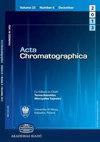Evaluation of various commercial lipid removal sorbents for the detection of 18 neonicotinoid insecticides and their metabolites in meat by liquid chromatography tandem mass spectrometry
IF 1.7
4区 化学
Q3 CHEMISTRY, ANALYTICAL
引用次数: 0
Abstract
Abstract A highly accurate and precise method for the simultaneous detection of 18 neonicotinoids and their metabolites in meat was developed using liquid chromatography-tandem mass spectrometry (HPLC-MS/MS). To improve the pretreatment step of the method, five different commercially available clean-up materials (including C18+PSA (primary secondary amine), Z-Sep (with Discover DSC-C18), EMR-Lipid, SHIMSEN QuEChERS, and Clean-up LPAS) were studied in the treatment of three meat matrices: pork, duck and yellow croaker. Based on the recovery data, we found that among the five purification materials, SHIMSEN QuEChERS was slightly more effective than the others for 18 neonicotinoids. Therefore, SHIMSEN QuEChERS was used as the purification sorbent, and the extraction solvents, extraction methods and chromatographic and mass spectrometric conditions were optimized. A matrix-matched calibration method was applied for quantification. In three different meat matrixes (pork, duck, and yellow croaker), all the target compounds showed good linearity, both with values of r 2 > 0.995. The average recovery of all neonicotinoids ranges from 63.4 to 114.2% (pork), 63.0–113.2% (duck), and 63.9–110.5% (yellow croaker). Relative standard deviations were all <15% for intraday and interday precision. The values of limit of detection (LOD) and limit of quantification (LOQ) were, respectively, ranging from 0.04 to 1.0 μg kg −1 and 0.10 to 2.0 μg kg −1 . Compared with previous reports, this method has advantage in LOQs, indicating that it it may be a preferred choice for the detection of neonicotinoid pesticides in meat samples.液相色谱-串联质谱法检测肉类中18种新烟碱类杀虫剂及其代谢物的各种商用脱脂吸附剂的评价
建立了一种高效液相色谱-串联质谱(HPLC-MS/MS)同时检测肉类中18种新烟碱类及其代谢物的方法。为了改进该方法的预处理步骤,研究了五种不同的市售清理材料(包括C18+PSA (primary - secondary amine)、Z-Sep (with Discover DSC-C18)、emr -脂质、SHIMSEN QuEChERS和cleanup LPAS)对猪肉、鸭肉和黄鱼三种肉类基质的处理效果。根据回收率数据,我们发现在5种净化材料中,SHIMSEN QuEChERS对18种新烟碱的效果略高于其他材料。因此,采用SHIMSEN QuEChERS作为纯化吸附剂,对提取溶剂、提取方法和色谱质谱条件进行优化。采用矩阵匹配定标法定量。在3种不同的肉类基质(猪肉、鸭肉和黄花鱼)中,所有目标化合物均表现出良好的线性关系,其值均为r2和gt;0.995. 新烟碱类杀虫剂的平均回收率分别为63.4 ~ 114.2%(猪肉)、63.0 ~ 113.2%(鸭)和63.9 ~ 110.5%(黄鱼)。日内和日间精度的相对标准偏差均为<15%。检出限和定量限分别为0.04 ~ 1.0 μg kg - 1和0.10 ~ 2.0 μg kg - 1。与以往报道相比,该方法在定量限上具有优势,可能是肉类样品中新烟碱类农药检测的首选方法。
本文章由计算机程序翻译,如有差异,请以英文原文为准。
求助全文
约1分钟内获得全文
求助全文
来源期刊

Acta Chromatographica
化学-分析化学
CiteScore
4.00
自引率
0.00%
发文量
55
审稿时长
2.3 months
期刊介绍:
Acta Chromatographica
Open Access
Acta Chromatographica publishes peer-reviewed scientific articles on every field of chromatography, including theory of chromatography; progress in synthesis and characterization of new stationary phases; chromatography of organic, inorganic and complex compounds; enantioseparation and chromatography of chiral compounds; applications of chromatography in biology, pharmacy, medicine, and food analysis; environmental applications of chromatography; analytical and physico-chemical aspects of sample preparation for chromatography; hyphenated and combined techniques; chemometrics and its applications in separation science.
 求助内容:
求助内容: 应助结果提醒方式:
应助结果提醒方式:


